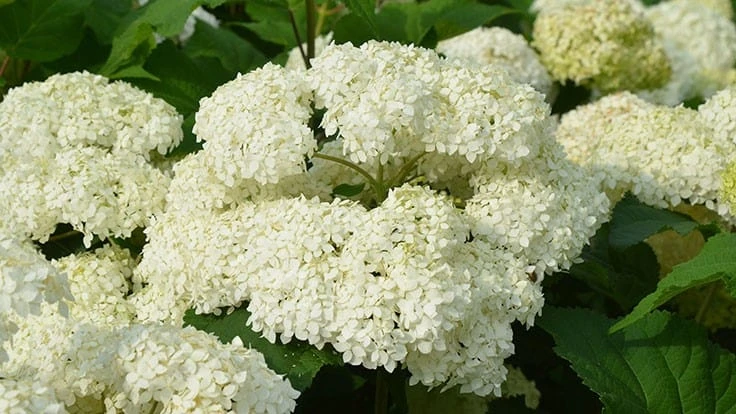
_courtesy_of_mt._cuba_center_(b)_fmt.png)
After five years of study, Mt. Cuba Center has released “Wild Hydrangea for the Mid-Atlantic Region,” a research report that evaluates 29 species and cultivars of this popular native shrub. Sam Hoadley, manager of horticultural research, evaluated Hydrangea arborescens and its relatives H. cinerea and H. radiata on horticultural merit, adaptability, and ecological value.
“Hydrangea arborescens are a classic landscape shrub that is currently undergoing a garden renaissance,” Hoadley says. “Their beauty, cultural adaptability, and ability to support wildlife make them a welcome addition to any garden in the mid-Atlantic region and beyond.”
The evaluation was conducted in full sun, and 19 taxa were also grown in 60 percent shade for comparison. Once established, one example of each hydrangea species and cultivar was cut back to 6 inches in late March to determine the effects of pruning on habit, bloom time, and flower size. Pollinator visits were studied to determine which hydrangeas have the greatest potential to support pollinators in home landscapes.
Mt. Cuba’s top nine horticultural performers are:
- Hydrangea arborescens 'Haas' Halo'
- Hydrangea arborescens 'SMNHALR' (Lime Rickey)
- Hydrangea arborescens 'NCHA2' (Invincibelle Spirit II)
- Hydrangea arborescens 'NCHA4' (Incrediball Blush)
- Hydrangea arborescens 'Abetwo' (Incrediball)
- Hydrangea arborescens 'Bounty'
- Hydrangea arborescens 'Dardom' (White Dome)
- Hydrangea arborescens 'Total Eclipse'
- Hydrangea arborescens 'Mary Nell'

The inflorescences of Hydrangea arborescens and its close allies fall into two categories: lacecaps and mopheads. Lacecap inflorescences are the predominant flower form in wild H. arborescens and contain hundreds of fertile flowers which are usually surrounded by a ring of showy sterile flowers. Mopheads, on the other hand, contain masses of sterile flowers in large, often dome-shaped flower heads with relatively few fertile flowers hidden within. The combined effect of the sterile flowers results in a spectacular ornamental display which contributes to the popularity of mophead hydrangeas in gardens.
Most hydrangeas in this trial bloom for just a few weeks in early summer, but the flower heads remain attractive through late summer and fall and add ornamental interest to winter landscapes. H. arborescens flowers are primarily white with several pink blooming cultivars that have been released in recent years. Unlike the color-changing inflorescences of non-native H. macrophylla and H. serrata, the flower color of the native species does not change depending on the acidity, or pH, of the soil in which they are grown.
While early cultivars such as Hydrangea arborescens ‘Grandiflora’ and H. arborescens ‘Annabelle’ were simple selections of unique naturally occurring plants, many newer cultivars are the result of selective breeding aimed at producing plants with desirable garden traits such as compact habits, sturdy stems, and new flower forms and colors.
Nearly half of the hydrangeas in this trial are lacecaps. Lacecap hydrangeas produce large numbers of fertile flowers, often between 800 and 900 per inflorescence, with some cultivars nearing almost 2,000 fertile flowers per inflorescence. Sterile flowers are produced in much smaller quantities and are located around the perimeter of the flower head. Only one hydrangea in the trial, H. arborescens ‘Eco Pink Puff’, produced no sterile flowers, and this cultivar had one of the highest counts of fertile flowers of any plant in the evaluation. Cultivars such as H. arborescens ‘Mary Nell’ and H. arborescens ‘Haas’ Halo’ are lacecap hydrangeas with exceptionally large inflorescences and more sterile flowers than the average lacecap. Both are considered to be of higher ornamental value than their wild-type counterparts.
Many recent Hydrangea arborescens introductions are categorized as mopheads. Mophead hydrangeas produce primarily sterile flowers, although fertile flowers are still present in most cases. The fertile flowers of mophead hydrangeas are often obscured by the large quantities of sterile flowers, which makes it difficult to determine when these plants are functionally in bloom. Mopheads have significant ornamental qualities, but pollinator studies have shown that they lack the ability to attract the large numbers of insect pollinators that lacecaps do.
Pollinator attraction
The variety of H. arborescens cultivars continues to grow and enables broader use in more horticultural niches thanks to ornamental breakthroughs. The introduction of hydrangea cultivars selected or bred for ornamental purposes raises questions about their ability to support wildlife, and this trial answered these questions by tracking pollinator visits.
The results show, with few exceptions, that lacecap hydrangeas are much more frequently visited by pollinators than mopheads. Mt. Cuba’s Pollinator Watch team, a trained group of volunteer citizen scientists, observed and recorded the number of pollinating insects visiting each of the 29 hydrangeas grown in full sun during 2019 and 2021.
_fmt.png)
Lacecap flowers are the predominant flower form in wild H. arborescens and contain hundreds of fertile flowers, usually surrounded by a ring of showy sterile flowers. Mopheads contain masses of sterile flowers in large, often dome-shaped flower heads, with relatively few fertile flowers.
H. arborescens ‘Haas’ Halo’, the top performer in the trial, is a cultivar offering both horticultural excellence and pollinator value. This cultivar produces exceptionally large and showy lacecap inflorescences that have proven to be highly attractive to insect pollinators.
View the entire report here: mtcubacenter.org/trials/wild-hydrangea-for-the-mid-atlantic-region.

Explore the February 2022 Issue
Check out more from this issue and find your next story to read.
Latest from Nursery Management
- John Ruter shares UGA's latest woody and herbaceous ornamental plant breeding projects
- Conor Foy joins EHR's national sales team
- Pantone announces its 2026 Color of the Year
- Syngenta granted federal registration for Trefinti nematicide/fungicide in ornamental market
- Get to know Kayela Aeppli
- HILA 2025 video highlights: John Gaydos of Proven Winners
- Q&A with Justin Bartlett
- Be the best choice





